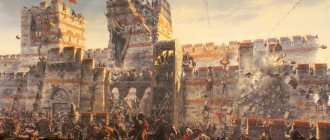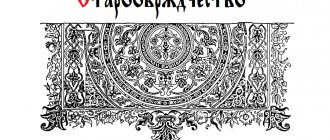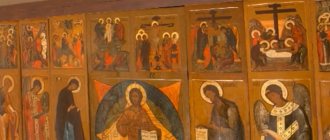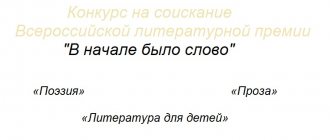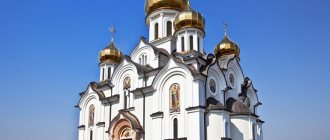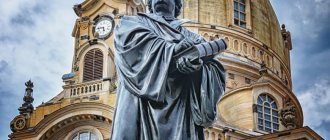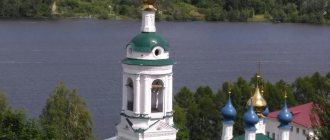Changes in the position of the Russian Orthodox Church
The Orthodox Church was one of the main forces that contributed to the unification of Russian lands. She supported the flexible policy of a forced alliance with the Golden Horde of Alexander Nevsky, and inspired Dmitry Donskoy to the Battle of Kulikovo. During the princely strife, the Orthodox Church openly advocated strengthening the power of the Grand Duke of Moscow.
In 1448, an important event took place in the life of the church: for the first time, a Russian metropolitan was elected in Moscow at a council
(meeting) of the Russian Orthodox clergy, and not appointed in Constantinople.
He became the Ryazan Metropolitan Jonah. And after the fall of Constantinople in 1453, the election of the metropolitan became an internal matter of the Russian Orthodox Church. She stopped depending on the Greek and gained complete independence
. The authority of the Russian Orthodox Church has increased. But these events had one more side: from now on the Russian Church was headed not by an envoy from Byzantium, but by a subject of the Russian sovereign, which in itself allowed for the possibility of his interference in church affairs. The grand dukes played an active role in the selection of the candidacy for the metropolitan.
CENTRALIZATION OF CULTS AND CHURCH MANAGEMENT.
The Church moved into the orbit of new socio-political relations, shaking off in time the weights of feudalism that were dragging it towards destruction.
However, the matter was not limited to the settlement of the economic base. Having broken with appanage feudalism and become subordinate to the Moscow “power,” the church had to centralize its cults and organization. The Moscow princes began to carry out centralization through individual measures taken in the process of fighting appanage feudalism; these measures, however, followed one systematic line. In relation to cults, the line followed was that the cult of local shrines after the annexation of an inheritance or region to Moscow was not destroyed, but was transferred to Moscow; The princes sought to turn the local shrine into a Moscow-wide shrine. By their own order, the princes could do this only in relation to local icons, which were transferred to Moscow and placed in the iconostasis of the Assumption Cathedral. This is how the icon of the Mother of God and the icon of Dmitry of Thessalonica moved to Moscow from the Vladimir cathedrals, after this grand-ducal city was conquered by Moscow and ceased to be the residence of the Grand Duke; further, an icon of the savior from conquered Novgorod, an icon of the Mother of God from Pskov and the same icon from Smolensk. The transfer of icons was based on the belief that icons transferred from conquered regions and cities cease to patronize their former region, but provide patronage only to Moscow, becoming a kind of “improvised” shrines of Moscow shrines; they were removed from independent thrones simultaneously with the removal of their princes from the throne. Thus, the Assumption Cathedral, or more precisely, its iconostasis, gradually became the pantheon of North-Eastern Rus'.
But besides the icons, there were also local patrons in the person of local saints. It was necessary to either ban their cults or sanction them as Moscow saints. Of course, the latter path was chosen. But here the Moscow prince could no longer act only by his princely orders. The sanction of the church was needed. Tsar Ivan the Terrible, by whose time political centralization had generally been completed, found himself a zealous assistant in this matter in the person of Metropolitan Macarius, an ardent Josephite, who at first was Joseph’s successor at the abbot’s see in the Volokolamsk monastery. In collaboration with the Tsar, Macarius convened two councils, 1547-1549, at which at least 30 of the largest local saints were canonized as Moscow-wide saints. The selection was made officially on the basis of information about miracles allegedly performed by the saints, but since all the local saints allegedly performed miracles, the tsar gave a directive to promote to the rank of national saints only those who were “glorified by God with many and ineffable miracles.” And remarkably, according to the preliminary lists compiled by the king and Macarius and then approved at the councils, such saints turned out to be not saints from appanage princes who headed the local pantheons, but saints from local bishops and monks. There were only two princes - Alexander Nevsky, who could not but be canonized due to his popularity, and the Novgorod prince Vsevolod-Gabriel, expelled from Novgorod by the veche in 1138. These new national saints were joined to the four former Moscow “miracle workers” - Metropolitans Peter, Alexei and Jonah and the founder of the Trinity Lavra, Sergius.
The centralization of church government was also already completed in the era of the councils of the mid-16th century. The very fact of the functioning of councils to resolve general church affairs is clear evidence of the change that has taken place. But we would be sorely mistaken if we began to look for the essence of the new church organization at the conciliar beginning. On the contrary, the cathedrals were only a screen that covered the establishment of unity of command in the church, and, moreover, the unity of command of the Moscow sovereign. It developed gradually during the 15th and early 16th centuries. In the process of its formation, both sides - both the new noble state and the capitalist church - moved towards each other halfway and saw each other as natural allies.
Having become from a feudal appanage to a Moscow nobility, the church did not change its social position in any way. In relation to the taxing people under her, she remained the same demanding gentleman. From this side, she was exposed, sparing no colors, by supporters of the boyar party, especially Maxim the Greek. Imitating the biblical prophets, Maxim puts into the mouths of the Lord and Mother of God fiery philippics against the church, which serves God with “red-voiced singing, the noise of good-voiced bells and the stench of blog-smelling”, clothes God in the icons with golden vestments and a golden crown, but all this brings him “from the unrighteous and godless profits, from covetousness and theft of other people’s estates,” these gifts “are mixed with the tears of orphans and poor widows and the blood of the poor.” From the side of the taxed people, protests against church domination in the middle of the 16th century were not yet heard, except for isolated phenomena like the spiritual-anarchist sect of the fugitive slave Theodosius Kosy, the Belozersk monk. According to the teachings of Kosoy, all church dogma and cult - temples, icons, relics, communion - are the work of human hands and have nothing to do with divine revelation, just like state organization. Christians should not have authorities, and they should not fight, and the whole religion consists solely of love for one’s neighbor.
These isolated manifestations of protest were harbingers of the great socio-religious crisis that erupted in the 17th century, when, after the turmoil, the “antichrist” noble Moscow state finally strengthened its power.
Monasteries
In the 15th century, monasteries in Russia flourished. Many new abodes for her appeared in different parts of the country. So, at the beginning of the century, three monks - Herman, Savvaty and Zosima
The Solovetsky Monastery was founded on the islands of the White Sea; in 1479, the famous church leader
Joseph Volotsky
founded the Joseph-Volokolamsky (Volotsky) Monastery. During the same period, differences between the monasteries became sharply noticeable. Some of them were fabulously rich, had large land holdings, and were engaged in trade and usury. Others existed in the form of hermitages and tiny forest deserts. In the deserts, monks lived by the labor of their hands and led an ascetic lifestyle.
The monasteries were enriched largely through the donations of believers.
The Orthodox Church preached the need for the dispensation of the soul of the deceased. It was believed that eternal bliss in the next world could be achieved through posthumous prayer, and in order to ensure such prayer, one should not skimp on generous donations to the monastery. To commemorate the soul, people donated church utensils, books and bells. The monks did not disdain grain, livestock, clothing and household utensils. But it was considered the most reliable thing to donate land to the monastery. When dividing property between heirs, rich landowners allocated a mandatory share in favor of the monastery. In their old age, the princes generously endowed the monasteries with villages and peasants and gave them letters of grant. Donations were accompanied by the establishment of “feed” for the benefit of all praying brethren - on the day of the angel and on the day of the death of the contributor. “Food” included food that was refined for those times: wheat bread instead of rye flatbread, honey kvass instead of simple fraternal kvass. The monks prescribed increasingly large sums for entering the name of the deceased in the monastery memorial books - synodics
. The inhabitants of rich monasteries began to lead a very free life.
The richest monastery in Russia was Trinity-Sergius, founded in the 14th century by Sergius of Radonezh. At the end of the 15th and beginning of the 16th centuries, the Joseph-Volokolamsk Monastery stood out. At its foundation, it received from the appanage prince Boris Volotsky
, brother of Ivan III, a rich village and large monetary donations.
The abbot of the monastery Joseph Volotsky (in the world Ivan Ivanovich Sanin
) sought to attract rich people to his monastery. Among the monks of the Volotsk monastery there were boyars and even scions of princely families. Crossing the threshold of the monastery, princes and boyars parted with their wealth. The monastery's holdings quickly expanded and the treasury was replenished. Over the course of seven years, Joseph spent a thousand rubles on the construction of a stone temple - an unheard of amount at that time. At the same time, the monastery spent large amounts of money on charity.
ESTABLISHMENT OF THE PATRIARCHATE.
An important milestone in the history of the Russian church was the establishment of the patriarchate. During the time of Ivan the Terrible, the importance of the Russian state in the international arena greatly increased. The strong blows inflicted by Ivan on church autonomy during the period of the oprichnina made the church a more obedient instrument in the hands of state power, which had assumed a theocratic character in Russia. A powerful state, where Orthodoxy was the official religion, claimed to replace the Byzantine Empire, which found itself under the rule of the Turkish conquerors. The greatness of the state had to correspond to the greatness of the church, the kingdom - the patriarchate.
The church, which sanctified the power of the Moscow sovereigns, played a major role in the internal political life of the country. But in relation to the Orthodox East, the Russian Church, despite its economic and political strength, remained in a subordinate position. Although the Moscow hierarchies went to Moscow for “alms” and here they sought protection from the “Hagarian” authorities, still in Moscow there was only a metropolitanate, while in the East there were patriarchates. It was necessary to eliminate this nominal dependence by bringing the legal status of the Russian Church in line with its actual position in the system of other Orthodox churches.
Things moved forward when in 1588 the Patriarch of Constantinople Jeremiah himself came to Moscow. He came for “alms,” but fell into the net set by Boris Godunov. When it became clear that the Patriarch of Constantinople refused to install a Moscow metropolitan in the Russian patriarchate, Boris Godunov came up with a cunning plan. It was decided not to let Jeremiah out of Russia until he gave his consent to the establishment of a new patriarchate here, and an empty promise to make himself Patriarch of Moscow was used as bait. To this proposal, “Jeremiah, imprudently and without consulting anyone, answered: I’m staying.”
As soon as the word “I stay” was uttered, the negotiations, which had previously stalled hopelessly, quickly moved forward. However, later things took a different turn. Jeremiah was offered to live not in Moscow, but in the once “initial place,” but now provincial Vladimir, citing his ignorance of the Russian language and local customs, as well as the tsar’s reluctance to let Metropolitan Job leave Moscow.
After Jeremiah’s refusal to settle in Vladimir, all disguise was discarded, and the tsar declared in the boyar duma that he would ask the patriarch to appoint Metropolitan Job to the patriarchate and to establish metropolises, additional archdioceses and bishoprics in Russia, so that in the future the election of Russian patriarchs would be carried out by a local church council without any -participation of Constantinople.
In January 1589, a church council of the highest church hierarchs was convened in Moscow, at which three candidates for patriarchs, previously indicated by the tsar, were nominated: Metropolitan Job, Archbishop Alexander of Novgorod and Pskov, and Archbishop of Rostov and Yaroslavl Varlaam. The final choice of the tsar, led by Boris Godunov, naturally fell on Job.
The ordination to the patriarchate was arranged with exceptional solemnity, accompanied by receptions in the palace and royal dinners.
The creation of the patriarchate was the work of the royal authorities. It was of great importance not only for the internal policy of the Moscow government, which increasingly subordinated the church to the state, but also marked an important stage in the history of the Russian church itself, increasing its role both in the country and in the international arena, among other Orthodox churches.
The theory, according to which Moscow alone preserved the purity of Orthodoxy and was called upon to replace the once lost Byzantium, gradually, throughout the 16th century, prepared minds for the fact that royal power should be “sanctified” by the patriarch. This has now been achieved. The ancient independence of the Russian Church from the Patriarch of Constantinople was consolidated and formalized in the norms of canon law. It became autocephalous formally and legally and at the same time acquired greater centralization.
True, at first the centralized church power did not even think of entering into any conflicts with the state to which it was subordinate in its actions. But subsequently, the presence of the patriarchate made it possible for the church, in the person of Patriarch Nikon, to begin competition with the secular authorities, and during the time of Peter’s reforms to become the center of reactionary opposition to the new transformations.
BIBLIOGRAPHY.
- Large illustrated encyclopedia of history: encyclopedia / Juman Holland et al. - M.: Makhaon, 2001. - 491 p.
- Nikolsky N.M. History of the Russian Church. – 3rd ed. – M.: politizdat, 1983. – 448 p.
- Ozhegov S.I., Shvedova N.Yu. Explanatory dictionary of the Russian language. M.: Azbukovik, 1999. – 944 p.
- Orlov A.S., Polunov A.Yu., Shchetinov Yu.A. A manual on the history of the fatherland for those entering universities. M.: Prostor, 1994. – 425 p.
- Sakharov A.N., Bokhanov A.N., Shestakov V.A. History of Russia from ancient times to the present day. M.: Prospekt, 2007. – 768 p.
- Native antiquity: national history in stories and paintings (from the 16th to the 17th centuries) / comp. V.D. Sinovsky. – M.: Sovremennik, 1993. – 446 p.
- Russian Orthodoxy: milestones in history/scientific. ed. A.I. Kalibanov. – M.: Politizdat, 1989. – 719 p.
- Yurganov A.L., Katsva L.A. History of Russia in the 16th – 18th centuries: a textbook for the 8th grade of secondary educational institutions. – M.: MIROS, Argus, 1997. – 526 p.
